Global Warming: How Science Works
Science is the facts. Houses are made of stone, and science is made of facts. But a bunch of stones is not a house, and a bunch of facts are not necessarily science.
- Jules Henri Poincare
With the greater height you fall, the faster you will move at the moment you meet the ground.
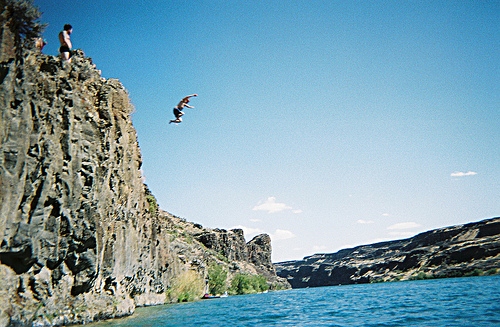
This seems quite obvious. This is intuitive, based on your experience. If you drop an egg from a high enough height, it will break.
And if jumping from a springboard is not so scary, a jump from a higher altitude may already start worrying you.

')
Even if you have never done this, you assume that by jumping from a high enough height, you can break at the end of the jump. So how can you find out if it is safe or not? Are you too high to jump?
Believe it or not, believe it or not, but it is from this that science consists, and that is how we become scientists.

We are inspired by one big myth about the scientific method, as if there is one permanent way to do science. If you remove all pretentiousness, it turns out that science is a way to understand the world around it.
If it happens, then what happens next? You do not sit with folded hands, pompously talking about their thoughts about this - you go and conduct an investigation. You are observing, taking measurements of all those things that happen in different conditions.
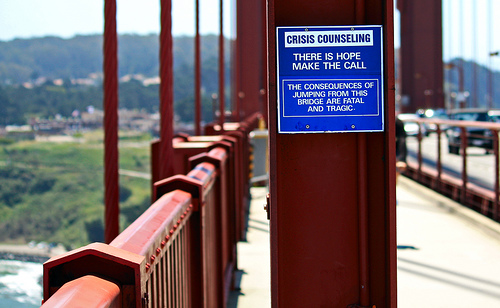
You may know that there are heights from which you can not jump safely, and even be able to quantify them. And when you are satisfied with your findings, you can put all the knowledge you have gained together, and say something clever and informed, like:
With the greater height you fall, the faster you will move when meeting with the ground.
And this statement brings all your investigations, observations, measurements and experience together, and describes not only your experience, but extrapolates it to a more general case, allowing you to make predictions of what will happen in cases that you have not tried to survive. .
Reaching this point, you will find yourself at the start of what can be called scientific theory. You can start making predictions if you configure the system in a certain way. If what your theory predicted happens, it confirms it. But every theory has limitations, a point where it stops working.

In our example, the theory stops working when the object reaches steady-state speed, when the air resistance force is compared with the gravitational force accelerating the fall. At this moment, the height from which you fell is no longer important - you will not fall faster.
But science, of course, can do more. Instead of the qualitative statement given above, we can determine, on the basis of a precise definition of all interacting forces (including gravity, air resistance, wind speed, etc.), how fast and in what direction will the falling object move at any time. Quantitatively.

And checking this theory every time in new conditions and under new circumstances, we either get confirmation that our best theory copes with new conditions, or we find out that the theory does not describe everything.
And most of the history of mankind, science progressed incredibly slowly.

Magnetism was first discovered in the 13th century (it was discovered by Pierre Peleren de Maricour ), but only in the 19th century was its connection with electricity and electric charge, and the successful description of quantum mechanics causing magnetism was made relatively recently.
Subsequent discoveries did not cancel early theories; they simply discovered the limitations of early ideas and went beyond them.
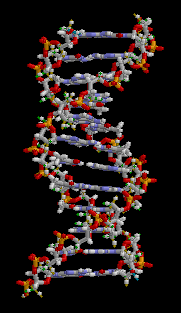
Biology did not begin with the discovery of the fundamental source of the genetic code. Before the structure and operation of DNA became known, scientists already knew a lot about genetics and heredity. If we crossed certain creatures with certain characteristics, we could long have predicted the characteristics that their offspring will possess.

And before understanding genetics — the mechanisms of inheritance — we could determine that the properties of living things change over time, including the main mechanism of this change.
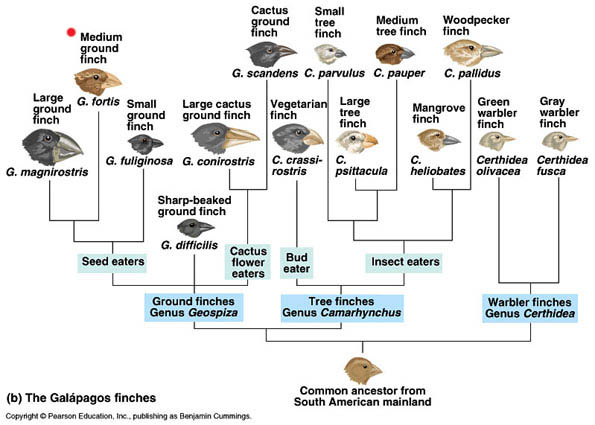
And even before Darwinism became the leading scientific theory, people engaged in animal husbandry to obtain the desired characteristics for 10,000 years.

Of course, today science already knows too much for one person to become an expert in all matters of all sciences. Therefore, we have scientific experts who know the important details of their fields. An alternative theory of evolution should not only explain everything that the theory of evolution explains, but also include genetics, DNA, and everything else that was built on evolution.
The same applies to the universe.

At some point in the past, the Big Bang theory was not even a leading theory about the early stages of the Universe. But there were observations — relic radiation, the evolution of galaxies, the initial abundance of elements — and the alternatives disappeared, unable to continue. Today, the Big Bang model predicts various phenomena — gravitational lensing, large-scale space structures, fluctuations in microwave background radiation, and so on. - and they all perfectly correspond to the observations, unlike any alternatives.

Reaching a scientific consensus on any problem is very difficult, because the evidence must be very convincing. If there are several reasonable explanations that correspond to the data obtained with at least some error, then no consensus can be reached.
We are skeptics. We do not believe explanations that just ring true. We observe. We are counting. We predict. We test and change our theories. We test their boundaries and move on. We require the repetition of experiments and the quantitative accuracy of the predictions of the theory.
But if all the alternatives turn out to be much worse - as in the case of evolution and the Big Bang - you will see that more than 95% of specialists in this field will agree. And when these facts constitute a threat to public health and safety, this is very important.
You will not die if you do not believe in the Big Bang. You will simply be wrong, and you will not have a deep and solid understanding of your origins and existence. You are free to choose, of course. But if you decide to taste mercury or lead, smoke a pack of cigarettes a day, breathe heavily polluted air, or swallow a small amount of polonium , the consequences will be much more serious. The same is true for the Earth.
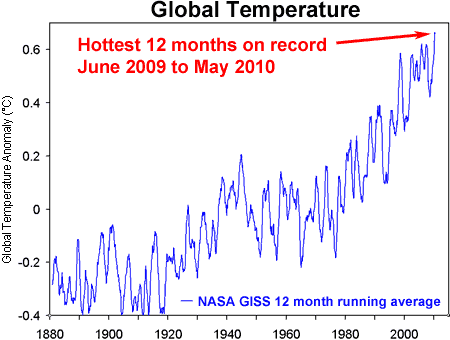
Scientists studying global warming and climate change have reached a consensus . I met a lot of skepticism, and although I gladly described the details in which I understand, I am not a climatologist, and I cannot be the expert who proves the theory’s motivation. I have to believe the experts and the consensus they have reached.
This consensus has four simple components:
1. The earth is heating and this heating is accelerating.
2. Heating is mainly caused by human activities characterized by greenhouse gas emissions.
3. If the emission of gases continues, the temperature will continue. As a result, ice caps will melt, the sea level will rise, and the climate of many regions will change dramatically.
4. All of these opportunities — and the attendant natural disasters — must be avoided, for they are harmful and dangerous.
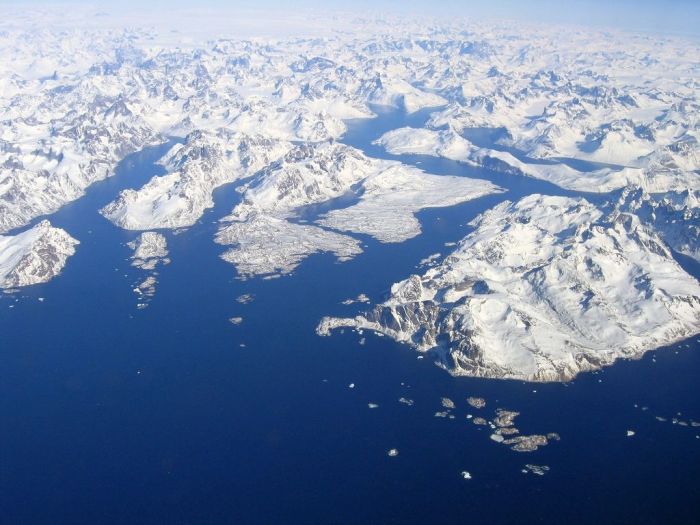
On the first three points, the consensus is very firm (corresponds to the 95% mentioned by me), and although I did not hear anyone meaningful object to the fourth point, it is possible that there are such opinions.
It is very difficult to object to the second and third points from a scientific point of view, because people have already thrown out more than a trillion tons of greenhouse gases, which led to an increase in temperature just as it would lead to an increase in your temperature wrapping in blankets. Physics is so clear and simple that - with the exception of the problem of quantitative modeling of the limits of increasing temperature - there is no room for discussion.
Therefore, skeptical about climate change personality focused on the first point: they are trying to deny the rise in temperature of the Earth and its acceleration. Richard Mueller , a well-known skeptic, called for measuring and carefully examining previous measurements of the global average temperature, and checking how much we should be confident in the claims of NOAA, NASA GISS and other sources that the temperature of the Earth is rising. What is the result?

The combined temperature database contains 1.6 billion records available at www.BerkeleyEarth.org . There you can read the work and check their results . As you can see, they confirm the results of previous works with great accuracy, showing that over the past 60 years the temperature has increased on average by 1 degree Celsius, and that over the past 30 years the growth rate has increased.
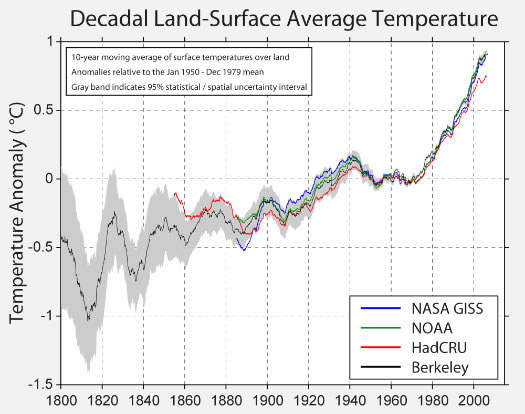
About the final report Muller wrote:
Most of all we were surprised that the new results so well coincided with the values previously published by other teams from the United States and Britain. This confirms that these studies were conducted carefully and that possible deviations seen by skeptics do not affect the conclusions of the work.
Many others also commented on this study, and they can also be read:
- blogs.discovermagazine.com/badastronomy/2011/10/21/new-independent-climate-study-confirms-global-warming-is-real
- dotearth.blogs.nytimes.com/2011/10/20/skeptic-talking-point-melts-away-as-an-inconvenient-physicist-confirms-warming
- scienceblogs.com/classm/2011/10/best_paper_in_urban_heat_islan.php
- www.huffingtonpost.com/kelly-rigg/the-war-against-climate-s_b_1027644.html
- arstechnica.com/science/news/2011/10/climate-skeptics-perform-independent-analysis-finally-convinced-earth-is-getting-warmer.ars
- news.discovery.com/earth/skeptic-led-study-ends-up-supporting-global-warming-evidence-111024.html?fb_ref=fb2&fb_source=home_oneline
- scienceblogs.com/deltoid/2011/10/the_berkeley_earth_surface_tem.php?utm_source=mostactive&utm_medium=link
The video can be very detailed to see exactly how the temperature has changed over time for all the observed regions of the Earth.
Science does not lie. A scientist should not be so arrogant as to believe that he alone can conclude from information. I am a scientist, but I am not the only good scientist. The measurements are good, the evidence is clear, the physics is simple. Unless new, extraordinary proofs emerge, I cannot think of reasons why scientific consensus can not be accepted all over the world and used to protect our greatest natural resource: the Earth.
Although there have already been cases when scientists were wrong, science is the best, and perhaps the only way to understand with the help of physics what is happening in the world and the Universe around us. So, do something about this - this is your world too!
Source: https://habr.com/ru/post/372891/
All Articles